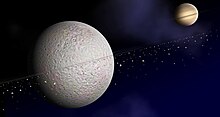|
Subsatellite A subsatellite, also known as a submoon or informally a moonmoon, is a "moon of a moon" or a hypothetical natural satellite that orbits the moon of a planet.[3] It is inferred from the empirical study of natural satellites in the Solar System that subsatellites may be rare, albeit possible, elements of planetary systems. In the Solar System, the giant planets have large collections of natural satellites. The majority of detected exoplanets are giant planets; at least one, Kepler-1625b, may have a very large exomoon, named Kepler-1625b I, which could theoretically host a subsatellite.[1][2][4][5] Nonetheless, aside from human-launched satellites in temporary lunar orbit, no subsatellite is known in the Solar System or beyond. In most cases, the tidal effects of the planet would make such a system unstable. TerminologyTerms used in scientific literature for subsatellites include "submoons" and "moon-moons". Colloquial terms that have been suggested include moonitos, moonettes, and moooons.[6] Possible natural instancesRhea There is a possible detection[7] of a ring system around Saturn's natural satellite Rhea that led to calculations that indicated that satellites orbiting Rhea would have stable orbits. The rings suspected were thought to be narrow,[8] a phenomenon normally associated with shepherd moons; however, targeted images taken by the Cassini spacecraft failed to detect any subsatellites or rings associated with Rhea, at least no particles larger than a few millimeters, making the chance of a ring system around Rhea slim.[9] IapetusIt has also been proposed that Saturn's satellite Iapetus possessed a subsatellite in the past; this is one of several hypotheses that have been put forward to account for its unusual equatorial ridge.[10] An ancient giant impact on Iapetus could have produced a subsatellite; as Saturn despun Iapetus, the subsatellite's orbit would then decay until it crossed Iapetus' Roche limit, forming a transient ring which then impacted Iapetus to form a ridge. Such a scenario could have happened on the other giant-planet satellites as well, but only for Iapetus and perhaps Oberon would the resulting ridge have formed after the Late Heavy Bombardment and thus survived to the present day.[11] Irregular moons of SaturnLight-curve analysis suggests that Saturn's irregular satellite Kiviuq is extremely prolate, and is likely a contact binary or even a binary moon.[12] Other candidates among the Saturnian irregulars include Bestla, Erriapus, and Bebhionn.[13] Artificial subsatellitesHistoricalMany spacecraft have orbited the Moon, including crewed craft of the Apollo program. In 1988, the Soviet Union unsuccessfully attempted to put two robotic probes on quasi-orbits around the Martian moon Phobos.[14] As of 2024[update], no spacecraft has successfully orbited any natural satellite other than the Moon. CurrentLaunched June 18, 2009, the Lunar Reconnaissance Orbiter (LRO) is a NASA robotic spacecraft currently orbiting the Moon in an eccentric polar mapping orbit. Data collected by LRO have been described as essential for planning NASA's future human and robotic missions to the Moon. Its detailed mapping program is identifying safe landing sites, locating potential resources on the Moon, characterizing the radiation environment, and demonstrating new technologies. CAPSTONE is a project launched in June 2022. Composed of a 12-unit collection of CubeSats which spent a few months in transit to the Moon to arrive in November 2022. It will spend about 9 months in the Moon's near rectilinear halo orbit. CAPSTONE is intended to test and verify the viability of the planned NRHO of planned future Lunar Gateway and its communication efficiency.[15] Future planned artificial moon satellitesThe interplanetary spacecraft JUICE launched in 2023 will enter an orbit around Ganymede in 2032, becoming the first spacecraft to orbit a moon other than Earth's. Additionally, the multi-agency supported Lunar Gateway human-rated space station is due to begin construction in 2024 in a near-rectilinear halo orbit (NRHO), primarily in support of the later stage NASA Artemis program missions to the Moon. Lunar Gateway will also potentially support future missions to Mars and outlying asteroids. See also
References
External links
|


